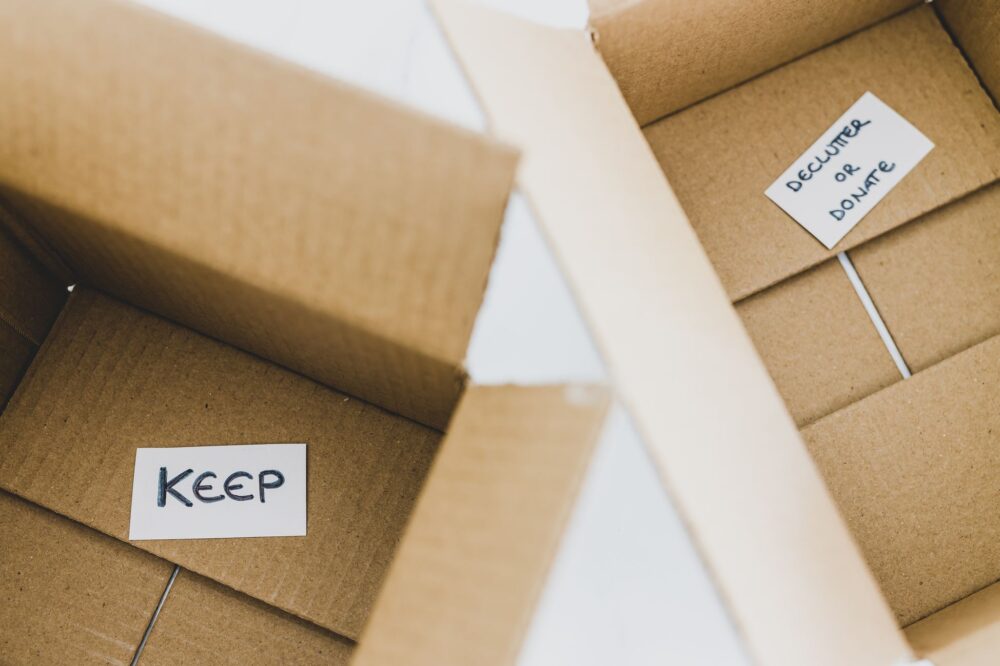We all want to relocate as stressless as possible, and learning what to get rid of when moving is one of the first things to do. That is an essential step because Americans consider the relocation process one of the three most stressful situations in their lives and because the less stuff you have, the less worried and overwhelmed you’ll be.

When you decided it’s the right time to move, you need to deal with the packing process. No matter if you’re using professional cross-country moving services or going with DIY, you’ll just have to determine which items to bring to your new place and which ones to leave behind. If you’re asking yourself how do you minimize when moving and what items are not worth moving, we have some awesome tips and tricks on how to declutter like a pro – especially if it’s your first time to move.
How to Decide What to Get Rid Of When Moving – Benefits of Decluttering
Relocating isn’t easy, especially when you consider that an average American lives in one home for 13 years. It’s more than a decade, and you can get attached to many items of your household and not to mention the neighborhood and people around you. However, there are many reasons to move, whether you’re relocating for love or you found a better job opportunity, and you have to start thinking about all of the tasks that await you for a stress-free move.
Deciding what not to pack is one of the first things you should do. But, before we get to the things to get rid of, let’s explain why and how it will benefit you. Not only will it shorten your relocation expenses checklist, but it will also save you a lot of time because the packing process could last for days. Don’t worry, with a good plan and guide, you’ll know all the packing tips you need.
Learn What Professional Long Distance Movers Won’t Move
When hiring a trustworthy relocation company, the important thing to know is that there are some ground rules of what can be packed and whatnot. No matter if you’re in a last-minute move, safety should be your priority, and that why you need to avoid these things professional cross country movers won’t move from your packing list:
- Hazardous materials and flammable items – anything corrosive, explosive, and weapons shouldn’t be on your list to pack.
- Perishable food – even though it’s not dangerous, rotten food could cause many problems during transportation. One of those is surely the unpleasant odor.
- Important and valuable belongings – irreplaceable items, like personal documents and valuable things, should be with you during the move.
- Pets and plants – pets aren’t allowed to move, and you can’t move plants, either, without special permission.
What Is the First Thing to Do When Moving – Declutter Your Home
Once you excluded all of the things movers won’t consider moving, you should start with decluttering your home. It’s a time-consuming process, but it can be done quickly and effortlessly with some relocation hacks. Decluttering is the essential step in every successful move, no matter if you’re relocating from an apartment to a house or it’s another way around. Making some free space and not dealing with things you don’t actually need is a good thing – be minimalistic.

Simple Tips and Tricks on How to Get Rid of Stuff Before Moving
Once you created your relocation budget, you realized you’d have to check the cheapest way to move out. There is no better way to save some money than getting rid of all the stuff you don’t use or need anymore. The crucial thing is not to leave this task for the moving day when packed boxes should be ready for professional long-distance movers to load into the truck. That is unless you agreed on additional packing services – in that case, the movers would pack some of your belongings. So, avoid relocating in a hurry and start by wrapping up at least two weeks ahead.
Purge Room by Room and Set Aside the Old and Unwanted Things
Purging your home can become a nightmare if you don’t know how to do it efficiently. The main thing about this process is giving yourself time and taking baby steps at the beginning. A couple of hours every day will be perfect because you won’t be too exhausted for other tasks from your relocation to-do list, and it won’t be overwhelming.
So purge one room of your place at the time and separate all the items you don’t feel like bringing with you, or you just don’t need them. That way, you won’t lose the entire day just on these tasks, and you’ll be sure there aren’t things you’ll forget when relocating.

Making a Checklist Of All Things You Won’t Pack Will Ease the Cross-Country Moving Process
Avoiding relocation stress should be your top priority, and you can achieve it with good organization and preparation. Like you have a checklist for a new apartment, why don’t you make one for the decluttering process? Making it visual will help you organize better, and you’ll know exactly where to start. This might seem unnecessary now, but when the moment comes for you to purge the entire home, you’ll gladly use some help and guide where to start, no matter how small or big it is.
Don’t Forget to Go Through All the Documents and Check What Can Be Tossed
When you decide to downsize and live minimalistic, you probably first think of clothes, furniture, and all the other household items. But what about your documents and paperwork? They somehow pass us by unnoticed, and in one moment, you have a house full of receipts and some important documents you don’t even know their due date. That’s why you should deal with the paper clutter, as well, and organize your documents and make more free space in your new place. Gather all the paperwork in one pile and toss the unneeded ones. For better organization, use some excellent tips from the video below to organize your documents at home.
Declutter Each Room in Your Place and Make Categories for Better Organization
Getting rid of unwanted things will not only help you pack faster and easier, but it will also mean a lot if you’re thinking about preparing your house for sale. The process of organizing the move isn’t an easy task, and you should be ready for the mess. However, a new buyer probably won’t think about that when it comes to checking the house. That’s why you need to view your home as a first-time buyer and eliminate the clutter that can leave a wrong first impression.
So, even if it could take some time to get it done, decluttering can also be fun. To make that happen, you could create four categories – label four boxes with signs “keep,” “trash,” “leave in storage,” and “give away.” Begin with one of the rooms, and don’t skip even the most insignificant item. After finishing that one room, you’ll be able to get a bigger picture of how much stuff you actually have, and it will be easier to know what to do with which category.

Main Question – What to Do With Old and Unwanted Things
So, you’re done with dividing and deciding what to keep, and the next question is what to do with the stuff in the non-relocating category. If you’re using long-distance moving services, you’ll have their storage facility available for some period, but it’s not a long-term solution. It’s easy for items with expiration dates – you’ll just throw them away or simply give them to your family and friends if there are few days left until the expiration. So, if you’re considering relocating the refrigerator, make sure you empty it completely. When it comes to packing your bathroom, before you pack anything, check the expiration date on each item because the odds are good there is something you should throw away. And now, let’s see what to do with old and unwanted belongings.
Sell or Donate the Stuff You Don’t Want in Your New House
There are many ways to sell or donate your belongings if you don’t want to move them. Organizing a garage sale is an event you could do on your own, but it will be more fun if you call your family and friends to help you. On the other hand, if you’re wondering where to donate old clothes, there are charities for those in need. Check the website Goodwill or contact some local charities and ask if you can donate toys and other stuff.

Additional Tips on Things to Get Rid Of When Moving
If you’re still unsure and wondering, “what should I throw away before I move,” don’t despair. Answer the following simple questions, and you’ll get the answer:
- Do you really need those items?
- Can you or will you buy that item again?
- In what condition are the belongings?
- Are you wearing those clothes all the time or once a year?
- Will that stuff even fit your new house?
When you answer these questions, you’ll be sure if something is worth relocating or not. There’s one thing left – furniture and other bulky items, so let’s check.
Explore Your Options on How to Get Rid Of Furniture When Moving
Relocating bulky items like furniture or bigger appliances is always challenging because you often get attached to them, or if not, they are too big, and you just don’t know what to do with them. Donating is a thoughtful way to help someone, but if you’re in the middle of a long-distance move, it will help your relocation budget as well. The fewer items you have, the lower the costs will be. So, once you decide to give away furniture, you can check with your family and friends if they may want them. If not, check with donation organizations and charities.

After All Decluttering Process Let the Reliable Long-Distance Moving Company Take Care Of Your Relocation
All the hard work of getting rid of clutter from your home is behind you, and you’re probably feeling relieved but tired at the same time. That’s why hiring a reliable cross-country relocation company is the right choice. Not only can they help you with relocation insurance of the belongings you decided to bring with you, but they can take care of the car transportation as well. That way, you can experience the relocation without stress and start right away and enjoy the new adventure that awaits you.





